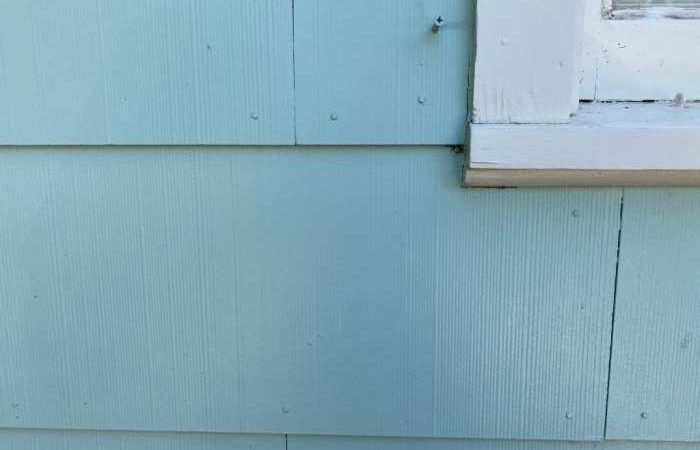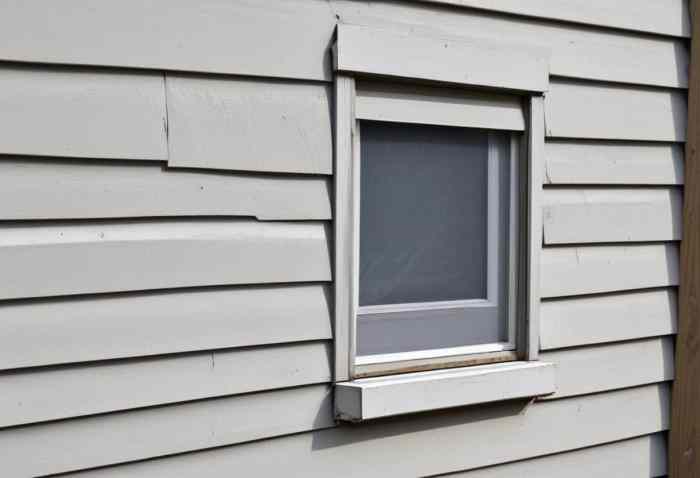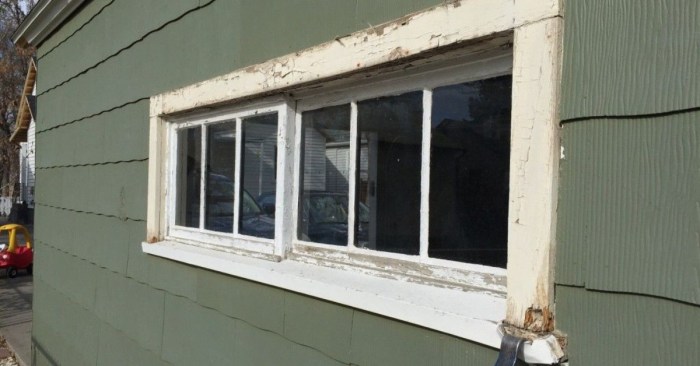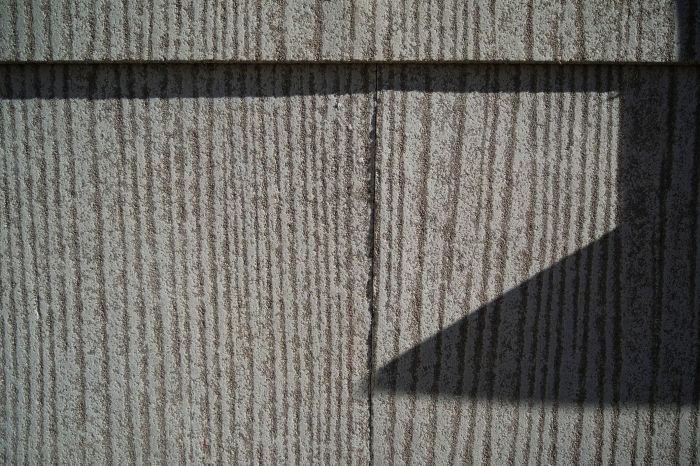Asbestos Siding A Comprehensive Guide

Asbestos siding, once a popular building material, now presents a complex issue. This guide delves into its history, from its initial appeal as a durable and fire-resistant option to the discovery of its significant health risks. We’ll explore its composition, properties, and the crucial safety measures surrounding its identification, removal, and disposal. Understanding asbestos siding is vital for homeowners, contractors, and anyone involved in building maintenance or renovation.
We’ll cover everything from identifying asbestos siding in your home to understanding the legal regulations concerning its handling. We’ll also examine safer alternatives and help you navigate the complexities of dealing with this potentially hazardous material responsibly and effectively.
Asbestos Siding

Source: westsideroofingpros.com
Asbestos siding, once a popular choice for homeowners, holds a complex place in building history. Its use was widespread due to its desirable properties, but its legacy is now inextricably linked to serious health concerns. Understanding its history is crucial to appreciating the current regulations and safety precautions surrounding asbestos-containing materials.
Asbestos Siding: A Historical Timeline
The use of asbestos in construction materials, including siding, boomed in the mid-20th century. Its fire-resistant and insulating properties, combined with its relative affordability and durability, made it an attractive option for builders and homeowners. This period saw widespread adoption, peaking roughly from the 1950s through the 1970s. The following timeline highlights key periods:
- Early 1900s – 1950s: Initial use of asbestos in various building materials gains traction. While not widespread in siding specifically, experimentation and early adoption occur. Manufacturing processes were less sophisticated compared to later periods.
- 1950s – 1970s: Peak popularity of asbestos siding. Mass production techniques lead to widespread availability and affordability, fueling its integration into suburban housing developments and commercial buildings across North America and other parts of the world. This era saw the development of various asbestos-cement siding products.
- 1970s – 1980s: Growing awareness of asbestos-related health risks leads to increased scrutiny and regulation. Studies linking asbestos exposure to diseases like mesothelioma and lung cancer begin to emerge, prompting a gradual decline in its use. Manufacturers start to phase out asbestos from their products.
- 1980s – Present: Asbestos is largely banned or heavily regulated in many countries. The production of new asbestos-containing siding ceases, and the focus shifts towards removal and safe handling of existing asbestos materials. Ongoing research continues to investigate the long-term health effects of asbestos exposure.
Types of Asbestos Siding Materials
Several types of asbestos siding materials were used throughout its period of popularity. The specific composition and manufacturing process varied, but all contained asbestos fibers, which were responsible for the material’s strength and durability.
- Asbestos-cement siding: This was the most common type, consisting of a mixture of asbestos fibers, cement, and other additives. It was often available in various colors and textures, mimicking the appearance of wood or other materials. The asbestos fibers provided strength and resistance to fire and damage.
- Asbestos shingles: Similar to asbestos-cement siding, these shingles were used for roofing and sometimes as a siding material. They offered similar benefits in terms of durability and fire resistance but presented the same health risks associated with asbestos exposure.
Asbestos Siding

Source: storables.com
Asbestos siding, once a popular choice for its durability, is now recognized for its significant health risks. Understanding its composition and properties is crucial for anyone dealing with older homes or buildings that may contain it. This section will delve into the specifics of asbestos siding, comparing it to modern alternatives.
Asbestos Siding Composition
Asbestos siding is a composite material. It typically consists of a mixture of asbestos fibers bound together with a cement-like matrix. The asbestos fibers themselves provide significant strength and resistance to fire and degradation. Several types of asbestos fibers were commonly used, including chrysotile (white asbestos), amosite (brown asbestos), and crocidolite (blue asbestos). Chrysotile, a serpentine mineral, was the most prevalent in siding due to its relatively flexible nature, allowing for easier shaping and molding during manufacturing. The other types, amphiboles, are more rigid and less commonly found in siding. The specific properties of the asbestos fiber, combined with the binding agent (often Portland cement), determine the overall characteristics of the siding. The ratio of asbestos to cement varied depending on the manufacturer and the desired properties of the final product.
Physical Properties of Asbestos Siding Compared to Other Materials
Asbestos siding possesses unique physical properties. Compared to vinyl siding, asbestos siding is significantly heavier, more durable, and more resistant to impact damage and fire. It’s also more resistant to rot and insect infestation than wood siding. However, vinyl siding is far more flexible and easier to install and maintain. Wood siding, while susceptible to rot and insect damage, offers a more aesthetically pleasing and naturally varied appearance than the uniformly textured asbestos variety. The inherent brittleness of asbestos siding, leading to potential for fiber release during damage, is a significant disadvantage compared to the more resilient and less hazardous alternatives.
Durability and Longevity of Asbestos Siding
Asbestos siding is renowned for its longevity. Many buildings clad in asbestos siding from the mid-20th century still stand today, showcasing the material’s exceptional resistance to weathering and degradation. This durability is a direct result of the inherent strength of asbestos fibers and the cement matrix. However, while durable, this longevity comes at a significant cost: the persistent risk of asbestos exposure during damage or demolition. Modern alternatives like vinyl and fiber cement siding offer comparable longevity without the inherent health risks. Fiber cement siding, in particular, is often marketed as a direct replacement for asbestos siding, boasting similar durability and fire resistance without the asbestos content. While the initial cost might be higher, the long-term health and safety benefits far outweigh the added expense.
Asbestos Siding
Asbestos siding, once a popular choice for its durability and fire resistance, now presents significant health risks due to the presence of asbestos fibers. Understanding these risks and taking appropriate precautions is crucial for anyone dealing with this material, whether during renovation, demolition, or simply regular maintenance.
Asbestos Siding: Health Risks and Safety Concerns
Inhaling asbestos fibers is the primary route of exposure and the most serious health concern associated with asbestos siding. These microscopic fibers, when inhaled, can become lodged deep within the lungs, causing a range of severe health problems. The body’s immune system struggles to eliminate these fibers, leading to long-term inflammation and damage. The severity of the health effects depends on several factors including the duration and intensity of exposure, the type of asbestos fibers involved, and individual susceptibility.
Potential Health Problems from Deteriorating Asbestos Siding
Deterioration and damage to asbestos siding significantly increase the risk of exposure. As the siding ages, it can become brittle and crumble, releasing asbestos fibers into the air. This is particularly dangerous during harsh weather conditions like strong winds or heavy storms, which can dislodge and spread fibers over a wide area. Even seemingly minor damage, such as cracks or holes, can release fibers, especially if disturbed during cleaning or repairs. This release of asbestos fibers poses a significant health threat to homeowners, workers, and even passersby. The potential for asbestos fiber release is heightened during activities such as power washing, sanding, or any type of renovation or demolition work involving the siding.
Preventative Measures to Minimize Asbestos Exposure
Minimizing exposure during asbestos siding removal or maintenance is paramount. The most effective approach involves hiring a licensed asbestos abatement contractor. These professionals possess the necessary training, equipment, and experience to safely remove or encapsulate asbestos-containing materials, minimizing the risk of fiber release. They follow strict safety protocols, including using specialized protective clothing, respirators, and containment methods to prevent the spread of asbestos fibers.
If undertaking minor repairs or maintenance yourself, take extreme caution. Always wet the surface before cleaning or working on it to minimize the release of airborne fibers. Use appropriate personal protective equipment (PPE), including a NIOSH-approved respirator, protective clothing, and eye protection. Never sand or grind asbestos-containing materials. If you’re unsure about the material, have it professionally tested before undertaking any work. Remember, even small-scale repairs can release dangerous fibers if not handled correctly.
Health Risks Associated with Asbestos Exposure
| Health Risk | Symptoms | Treatment Options |
|---|---|---|
| Asbestosis | Shortness of breath, chronic cough, chest pain, clubbing of fingers | Oxygen therapy, medications to manage symptoms, lung transplant in severe cases |
| Lung Cancer | Persistent cough, bloody sputum, chest pain, weight loss, fatigue | Chemotherapy, radiation therapy, surgery, targeted therapy |
| Mesothelioma | Chest pain, shortness of breath, abdominal pain, weight loss | Chemotherapy, surgery, radiation therapy, targeted therapy, palliative care |
| Pleural Diseases (e.g., pleural plaques, pleural thickening) | Often asymptomatic; may experience chest pain or shortness of breath in severe cases | Monitoring, treatment for associated symptoms |
Asbestos Siding

Source: thespruce.com
Asbestos siding, while once a popular building material, poses significant health risks if disturbed. Understanding how to identify and test for asbestos siding is crucial for homeowners, contractors, and anyone involved in demolition or renovation projects. This section will discuss methods for identifying asbestos siding, both visually and through testing, and will detail the necessary safety precautions.
Visual Inspection Techniques for Asbestos Siding
Visual inspection is the first step in identifying potential asbestos-containing siding. However, it’s important to remember that visual inspection alone is not conclusive; laboratory testing is necessary for definitive identification. Characteristics to look for include the texture, color, and the presence of any identifying markings. For example, older siding might have a textured, slightly rough surface, and might be a variety of colors including grey, brown, or even reddish hues. Some asbestos siding may show visible signs of weathering or degradation. The presence of manufacturer’s markings, often stamped or painted on the siding, can sometimes indicate the presence of asbestos, but this is not a guarantee. Remember, even if the siding looks like asbestos, professional testing is crucial for confirmation.
Asbestos Testing Kits and Their Use
Home asbestos testing kits are available commercially. These kits typically involve collecting a small sample of the siding material and sending it to a certified laboratory for analysis. The instructions provided with the kit should be followed carefully. It is important to note that these kits offer a degree of accuracy, but they are not as reliable as professional testing. The results from a home test kit should be considered presumptive, and professional testing is often recommended for crucial decisions, like major renovations or demolitions. Proper sample collection is vital for accurate results; collecting a representative sample of the material is key.
Professional Asbestos Testing and Result Interpretation
Professional asbestos testing involves a certified asbestos professional collecting samples according to established safety protocols and sending them to a nationally accredited laboratory for analysis. The laboratory uses Polarized Light Microscopy (PLM) or Transmission Electron Microscopy (TEM) to identify asbestos fibers. The test results will typically indicate the presence or absence of asbestos and, if present, the type and concentration of asbestos fibers. A report detailing the findings will be provided. A positive result means asbestos is present; a negative result means that asbestos was not detected within the limits of the test’s sensitivity. Understanding the concentration levels reported is crucial; higher concentrations indicate a greater risk.
Safety Precautions During Asbestos Siding Inspection and Testing
Working with potentially asbestos-containing materials requires stringent safety precautions. Always assume that the siding contains asbestos until proven otherwise through professional testing. Never disturb or damage the siding during inspection or sampling. Wear appropriate personal protective equipment (PPE), including a respirator rated for asbestos, gloves, and eye protection. Proper ventilation is also crucial to minimize exposure to airborne asbestos fibers. After sampling or any interaction with the siding, thoroughly clean the work area and dispose of waste materials according to local regulations. If significant demolition or renovation work is planned, consult with a qualified asbestos abatement contractor to ensure safe removal and disposal. Ignoring safety precautions can lead to serious health consequences.
Asbestos Siding
Asbestos siding, while once popular for its durability and fire resistance, presents significant health risks if disturbed. This section details the safe removal and disposal procedures necessary to mitigate these risks. Improper handling can lead to the release of asbestos fibers, which are a known carcinogen. Understanding the regulations and employing the correct techniques is crucial for protecting both workers and the environment.
Asbestos Siding Removal Procedures and Regulations
Safe asbestos siding removal requires adherence to strict local, state, and federal regulations. These regulations often mandate the involvement of licensed asbestos abatement contractors. Before commencing any removal, you must obtain the necessary permits from your local environmental protection agency. These permits typically require a detailed asbestos abatement plan outlining the project scope, safety protocols, and waste disposal methods. Failure to comply with these regulations can result in hefty fines and legal repercussions. The specific requirements will vary depending on location and the quantity of asbestos-containing material. For example, some jurisdictions may have stricter rules for projects involving larger surface areas or older buildings.
Packaging and Disposal of Asbestos-Containing Materials
Once the asbestos siding is removed, proper packaging and disposal are paramount. The removed material must be double-bagged in heavy-duty, six-mil polyethylene bags. These bags should be sealed tightly with tape to prevent fiber release. Each bag must be clearly labeled with the words “Asbestos,” “Danger,” and the date of removal. The disposal of asbestos-containing waste is typically handled by licensed asbestos disposal facilities. These facilities are equipped to safely manage and dispose of asbestos waste by environmental regulations. Improper disposal can lead to environmental contamination and potential health hazards for those who come into contact with the waste.
Asbestos Abatement Techniques
Several asbestos abatement techniques exist, each with its advantages and disadvantages. Encapsulation involves sealing the asbestos siding with a sealant to prevent fiber release. This method is often less disruptive than removal but doesn’t eliminate the asbestos hazard. Enclosure involves completely covering the asbestos-containing material with a non-asbestos barrier, similar to encapsulation but providing a more robust containment. Removal, as discussed previously, involves the complete removal and disposal of the asbestos-containing material. The choice of technique depends on factors such as the condition of the siding, the cost, and the level of risk involved. Often, a risk assessment is conducted to determine the most appropriate approach.
Step-by-Step Guide for Safe Asbestos Siding Removal
Before initiating any removal, remember to consult with a licensed asbestos abatement contractor. They will provide expert guidance and ensure compliance with all regulations. This guide provides a general overview and should not be considered a substitute for professional advice.
- Preparation: Obtain necessary permits and notify relevant authorities. Establish a designated work area and ensure proper ventilation.
- Protective Gear: Don appropriate personal protective equipment (PPE), including a respirator, coveralls, gloves, and eye protection.
- Wetting: Thoroughly wet the asbestos siding with water to minimize fiber release during removal.
- Removal: Carefully remove the asbestos siding in small sections, avoiding any damage to the underlying structure. Use appropriate tools, such as saws and scrapers, and work methodically.
- Double Bagging: Immediately place the removed asbestos siding into heavy-duty, six-mil polyethylene bags. Seal the bags tightly with tape.
- Labeling: Clearly label the bags with the words “Asbestos,” “Danger,” and the date of removal.
- Disposal: Transport the bagged asbestos waste to a licensed asbestos disposal facility.
- Cleanup: Thoroughly clean the work area, removing any residual asbestos fibers.
Asbestos Siding
Asbestos siding, while once a popular choice for its durability and fire resistance, is now recognized as a significant health hazard. The fibers released during damage or deterioration can cause serious respiratory illnesses. Therefore, replacing asbestos siding is crucial for homeowner safety and well-being.
Asbestos Siding Alternatives and Replacement Options
Several modern alternatives offer comparable or superior performance without the health risks associated with asbestos. These options vary in cost, lifespan, maintenance requirements, and aesthetic appeal, allowing homeowners to choose the best fit for their needs and budget. Choosing the right replacement not only enhances the curb appeal of a home but also protects the health and safety of its occupants.
Modern Siding Material Properties, Costs, and Benefits
Vinyl siding is a popular and cost-effective choice. It’s relatively inexpensive, easy to install and maintain, and comes in a wide array of colors and styles. However, it’s not as durable as some other options and can be susceptible to damage from extreme weather. Fiber cement siding, on the other hand, is significantly more durable and resistant to fire, insects, and rot. While more expensive than vinyl, its longer lifespan and lower maintenance needs often make it a worthwhile investment. Wood siding offers a classic and aesthetically pleasing look, but requires more maintenance than vinyl or fiber cement and is susceptible to rot, insect damage, and fire. Metal siding, typically aluminum or steel, is highly durable, low-maintenance, and fire-resistant, though it can be more expensive and may dent or scratch more easily than other options.
Aesthetic Comparison of Asbestos Siding and Modern Alternatives
Asbestos siding typically had a relatively plain, somewhat textured appearance, often in muted colors. Modern alternatives offer a much broader range of aesthetic options. Vinyl siding can mimic the look of wood, brick, or stone, while fiber cement siding can be textured to resemble wood shakes or other natural materials. Wood siding provides a classic, natural look, and metal siding can be designed to achieve a contemporary or industrial aesthetic. The choice ultimately depends on the homeowner’s personal preference and the architectural style of the house.
Comparison of Siding Materials
| Material | Cost (per sq ft, approximate) | Lifespan (years) | Maintenance | Environmental Impact |
|---|---|---|---|---|
| Vinyl | $3-$8 | 20-30 | Low | Moderate (manufacturing and disposal) |
| Fiber Cement | $8-$15 | 50+ | Low | Moderate (manufacturing) |
| Wood | $10-$20+ | 20-50 (depending on type and maintenance) | High | Variable (depending on sourcing and treatment) |
| Metal | $10-$20+ | 50+ | Low | Moderate (manufacturing and disposal) |
Asbestos Siding
Asbestos siding, while once a popular building material due to its durability and fire resistance, presents significant legal and regulatory challenges today because of its inherent health risks. Understanding the legal landscape surrounding asbestos siding is crucial for homeowners, contractors, and anyone involved in property management or renovation. This section will discuss Artikel key legal and regulatory aspects related to asbestos siding, including handling, removal, and disposal, as well as liability considerations.
Asbestos Siding: Relevant Legislation and Regulations
Numerous federal, state, and local regulations govern the handling, removal, and disposal of asbestos-containing materials, including asbestos siding. These regulations are designed to protect public health and the environment. Specific regulations vary by location, but common themes include licensing requirements for asbestos abatement contractors, strict protocols for asbestos removal and disposal, and notification requirements for property owners and regulatory agencies. For instance, the U.S. Environmental Protection Agency (EPA) has established guidelines for asbestos handling, though states often have more stringent regulations. These regulations typically cover aspects such as worker protection (including the use of appropriate personal protective equipment), proper containment during removal, and disposal in designated landfills that are equipped to handle asbestos waste. Failure to comply with these regulations can result in significant fines and legal penalties.
Liability Issues Related to Asbestos-Containing Materials
Liability for asbestos-related issues can be complex and multifaceted. Property owners may be held liable for asbestos-related illnesses suffered by occupants or workers if they knew or should have known about the presence of asbestos and failed to take appropriate action, such as proper maintenance or abatement. Similarly, contractors involved in demolition or renovation work can be held liable for asbestos exposure if they failed to follow proper safety protocols. Product manufacturers may also face liability if their products were found to contain asbestos and caused harm. Establishing liability often involves demonstrating negligence or a breach of duty of care. Cases involving asbestos exposure often involve lengthy litigation and substantial financial settlements or judgments. A notable example is the long history of litigation against asbestos manufacturers, resulting in billions of dollars in payouts to victims of asbestos-related diseases.
The Role of Environmental Agencies in Regulating Asbestos
Environmental agencies at the federal, state, and local levels play a critical role in regulating asbestos. Agencies like the EPA in the United States set national standards and guidelines, while state and local agencies often implement and enforce more specific regulations tailored to their regions. These agencies are responsible for monitoring asbestos-related activities, issuing permits for asbestos abatement projects, inspecting work sites to ensure compliance with regulations, and investigating complaints related to asbestos exposure. They also educate the public about the risks of asbestos and guide safe handling and disposal practices. The EPA, for example, maintains a database of asbestos-related information and resources to aid in compliance and public awareness. These agencies’ enforcement actions, which can include fines and legal action, are crucial in ensuring that asbestos-containing materials are handled safely and responsibly, minimizing risks to public health and the environment.
Asbestos Siding

Source: duboselawfirm.com
Asbestos siding, while once a popular building material due to its durability and fire resistance, presents significant health risks if disturbed. Understanding the challenges associated with its removal and the consequences of improper handling is crucial for homeowners, contractors, and demolition crews alike. This section will explore real-world examples of asbestos siding projects, highlighting both successful remediation and the potential dangers of neglecting safety protocols.
Asbestos Siding Removal Case Studies
Several case studies illustrate the complexities involved in asbestos siding removal. One example involves a 1950s-era school in a small town. The aging siding, identified as containing asbestos, required careful removal before a planned renovation. The project involved meticulous planning, including air monitoring, specialized containment structures, and the use of trained and certified abatement professionals. Workers wore full protective gear, including respirators and protective suits. All debris was carefully bagged and transported to a licensed disposal facility. The project was completed successfully, minimizing environmental and health risks. Another case study focuses on a large commercial building in an urban area. Here, the sheer scale of the project, along with the proximity to other buildings and public spaces, presented unique challenges. The abatement process involved a phased approach, minimizing disruption to the building’s occupants and surrounding areas. Detailed pre-abatement surveys were crucial in identifying the precise location and extent of the asbestos-containing material.
Consequences of Improper Asbestos Siding Handling
Imagine a demolition crew, unfamiliar with asbestos handling procedures, beginning to tear down a house with asbestos siding. They use standard demolition tools, creating a cloud of asbestos dust that billows into the air. The dust, invisible to the naked eye, settles on nearby surfaces, contaminating the surrounding area. Workers, breathing in the microscopic asbestos fibers, experience no immediate symptoms. However, years later, some develop asbestosis, a debilitating lung disease. Neighbors, unknowingly exposed to the airborne fibers, also face potential health risks, including lung cancer and mesothelioma. The site becomes a contaminated area, requiring costly and extensive remediation efforts. The legal ramifications are significant, potentially resulting in substantial fines and lawsuits for the demolition company and property owners. This scenario underscores the critical need for strict adherence to safety regulations and the use of trained professionals when dealing with asbestos siding.
Last Point
Dealing with asbestos siding requires careful consideration and adherence to safety protocols. While it offers insights into the past of building construction, its legacy is inextricably linked to potential health hazards. This guide aims to equip you with the knowledge to approach asbestos siding safely and make informed decisions regarding its presence in your property. Remember, professional assistance is crucial when dealing with asbestos removal; prioritize your health and safety.
Comments are closed.